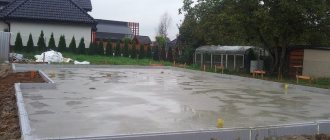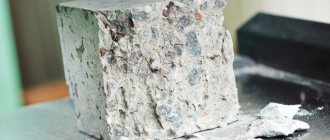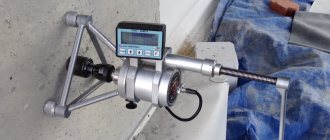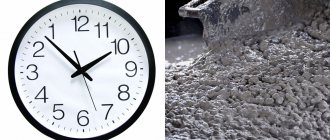Design strength
Design strength (grade) is the standardized strength of concrete at the age of 28 days or at other times, allowing the transfer of the full design load to the product. If the design documentation, GOST or technical specifications for the product do not indicate the period for concrete to reach the design grade, then this period should be considered 28 days from the date of manufacture.
The average values of the coefficients of increase in strength of concrete using cements of various types, hardening in the open air at positive temperatures at the age of 90 and 180 days, are given in Table. 5.
Transfer strength
Transfer strength is the standardized strength of concrete of prestressed products at the moment the pre-tensioning reinforcement is transferred to it.
The value of the transfer strength of concrete is regulated by the project, GOST or TU for this type of product.
The transfer strength of concrete is assigned to not less than 70% of the design grade, which is usually accepted for prestressed products, depending on the type and class of prestressed reinforcement; in this case, the actual value of the transfer strength, taking into account the requirements of statistical control in production, must be at least 14 MPa, and for bar reinforcement of class Αt-VI, reinforcing ropes and wire reinforcement without intermediate heads - at least 20 MPa.
| Properties of concrete | Designations | Unit _ | Conversion formula (ratio) |
| Prismatic strength | RPr | MPa | |
| Axial tensile strength | RP | MPa | |
| Bending tensile strength | RР. And | MPa | |
| Initial modulus of elasticity | EB | MPa | |
| Shear modulus | G6 | MPa | |
| Strength of adhesion to reinforcement Fatigue limit | RSc | MPa MPa | |
| Shear strength (chipping) | RCp | MPa | |
| Crushing strength | RCm | MPa | I |
| Coefficient of linear expansion when heated from 0 to 100°C | α | Grad-1 | |
| Concrete shrinkage (ultimate compressibility) | Mmm | 0,2 – 0,4 | |
| The same, reinforced | Mmm | 0,15 | |
| Creep characteristic | φ+ | — | |
| Ultimate elongation | Mmm | 0,1—2 | |
| Coefficient of thermal conductivity | λ | W/(m.k) | λ ≈ 1.4 |
| Abrasion | AND | G/cm2 | I = 0.01 – 0.1 |
The main characteristics and physical properties of heavy concrete are given in table. 4.
What does strength gain depend on?
Factors that control the set of strength properties of stone include: how much time has passed after pouring, temperature and humidity conditions, quality (activity) and grade of cement, ratio of water and cement in the solution, proportions of components in the mixture, method of compaction, mixing technology, method and the speed of laying, the quality and regularity of moisture, the presence of plasticizers (hardening accelerator additives) in the mixture in winter, etc. Raising the grade of concrete depends on an increase in the proportion and higher grade of cement in the mixture, the proportions of the components. The brand directly affects the strength gain of concrete. For low grades, critical strength is more important. Table 2 reflects this pattern.
Therefore, the strength of a high-grade concrete foundation determines the reliability and durability of the building structure. In cold weather, stone gains strength due to its own heat generation, but to normalize the stone formation schedule, it is advisable to use appropriate additives that accelerate hardening and reduce the temperature at which hydration stops. With them, the mixture gains brand strength after 14 days. A good solution would also be to change the components in concrete. For example, aluminous cement gains strength even in cold weather, as it releases approximately 7 times more of its own heat compared to Portland cement.
The shape and grain fraction of natural fillers play a significant role in achieving this property. Their irregular shape and increased roughness provide better adhesion conditions and quality of concrete. It is known that an increase in the proportion of water in a concrete mixture can lead to separation of the mass of material. The consequence of this is also that with a relative increase in the proportion of water in the solution by 60% of the optimal value (w/c = 0.4), a decrease in strength by 50% of the brand value occurs. However, with a water/cement ratio of 1/4, the curing (hardening) period is halved.
To speed up the process and minimize the curing of concrete, it is advisable to use sand concrete with a low water/cement ratio. An uncompacted concrete solution has a chance to mature only to 50% of the standard strength, even with an optimal water/cement ratio. At the same time, manual compaction can increase its strength by 30 - 40%, and vibrating rammer increases the strength to the standard 95 - 100%.
Reinforcement for heavy concrete
| Type and class of prestressed reinforcement | The design grade of concrete is not lower than |
| Wire reinforcement classes: | |
| BH with anchors | 250 |
| Bp-II without anchors with wire diameter: up to 5 mm inclusive | 250 |
| 6 mm or more K-7 (GOST 13840-68 *) | 400 |
| K-19 (TU 14-4-22-71 *) | 350 |
| From 10 to 18 mm (inclusive) classes: | |
| A-IV and Αt-IV | 200 |
| AV and Αt-V | 250 |
| Αt-VI | 350 |
| 20 mm and more classes: | |
| A-IV and Αt-IV | 250 |
| AV and Αt-V | 350 |
| Αt-VI | 400 |
Table 5
| Type and mineralogical composition of cement | K coefficient value, day | |
| 90 | 180 | |
| Aluminate Portland cement (C3 A ≥ 12%) | 1,05 | 1.1 |
| Alite Portland cement (C3 S ≥ 50%; C3 A ≤ 8%) | 1,05 | 1,1 |
| Pozzolanic Portland cement, Portland slag cement with slag content up to 40% | 1,05 | 1,25 |
| Belite Portland cement and slag Portland cement with a slag content of more than 50% | 1,1 | 1,3 |
Note. The values of K can be determined by the formula K = log / log28 for n > 3, where
P – age of concrete in days. The data obtained can be used for approximate calculations of concrete composition. In this case, the strength of concrete aged n days (RN) is determined by the formula RN = R28 • K.
If the design grade of concrete is accepted above the specified minimum value, then the transfer strength must be at least 50% of the adopted design grade.
ADDITIONAL REQUIREMENTS FOR CONTROL OF CONCRETE STRENGTH BY NON-DESTRUCTIVE METHODS
1. For non-destructive testing, the following is taken as a single value:
- when monitoring structures of flat and hollow-core floor slabs and coverings, road slabs, panels of internal load-bearing walls, wall blocks, as well as pressure and free-flow pipes - the average strength of the concrete of the structure, calculated as the arithmetic average of the strength of the concrete of the controlled sections of the structure;
- in all other cases, including monolithic and prefabricated-monolithic structures, - the average strength of concrete of the controlled section of the structure (or part of a monolithic, prefabricated-monolithic structure).
2. Control of concrete strength by non-destructive methods (ultrasonic pulse or mechanical) in the case where the average strength of concrete in a structure is taken as a single value is carried out using a calibration relationship previously established in accordance with the requirements of current state standards for these methods.
3. Monitoring the strength of concrete by non-destructive methods in the case where the average strength of concrete in the controlled area is taken as a single value is carried out using the correction factor K
n in formula (), which is determined before the transition to these methods with each change in the nominal composition of concrete, the manufacturing technology of the structure, the type of materials used, with each new establishment of a calibration relationship, but at least once a year.
Factor K
n is calculated using the formula
where Vn.m is the coefficient of variation in the strength of concrete of all series of samples tested by non-destructive method to establish the calibration dependence;
V
o is the coefficient of variation in the strength of concrete of the same series of samples tested by loading to establish the calibration dependence.
To establish the calibration dependence, the value of the coefficients of variation V
o and
V
n.m are determined using a formula similar to formula (7).
Tempering strength
Release strength is the standard strength of concrete at which the product is allowed to be shipped from the factory to the consumer.
The value of the tempering strength of concrete products is regulated by GOST for this type of product, and in the absence of GOST or if the value of the tempering strength is not regulated by GOST, it is established by the manufacturer in agreement with the consumer and the design organization.
The value of the tempering strength is determined taking into account the conditions of transportation, installation and the period of load transfer to the products, as well as taking into account the technology of their manufacture and the possibility of further increasing the strength of concrete in the products, depending on the climatic conditions of the construction area and the time of year.
In this case, the value of the tempering strength of concrete as a percentage of its design grade for compressive strength must be no less than the grade given below; it is allowed only in cases where loads close to the design ones can be tolerated during transportation and installation of the product; in the cold season, if conditions cannot be created for an increase in the strength of concrete before the design load is transferred to the product.
| Concrete in products | Tempering strength, percent. from the design brand, no less |
| Heavy concrete and concrete with porous aggregates | |
| M150 and above | 50 |
| Heavy concrete M100 and below | 70 |
| Concrete on porous aggregates Ml00 and below | 80 |
| Concrete of all types and grades, produced with autoclave processing.... | 100 |
Recruitment process
Concrete is a popular stone material that is created from a mixture of water, binder and aggregate. It contains specialized additives that are responsible for special properties and functions.
During the hydration process, reliable monolithic compounds are formed, which acquire the properties of durable artificial stone. It takes several weeks (up to 28 days) to form a monolith, and obtaining factory quality takes up to 6 months.
The maturation of concrete consists of 2 stages:
- Grasping. Is the initial stage.
- Hardening. Finishing stage.
Knowing all the maturation standards, you can determine how many years a monolithic structure will last.
Grasping
The building material cannot be used immediately after pouring. Before doing this, you need to familiarize yourself with the schedule of concrete strength gain and the specifics of each stage of its maturation. Often the mixture is delivered to the construction site using special equipment, so it is kept in a moving state using automated equipment. Thixotropy technology maintains the basic consistency parameters until the moment of pouring, suspending natural ripening.
But if the mixture is kept for longer than the permissible time or exposed to high temperatures, the required performance properties will deteriorate. The concrete strength development chart mentions that it sets in a period of 20 minutes to 20 hours. If work is performed at sub-zero temperatures in winter, the term will increase to 6-10 hours.
To protect the structure from deformation, it is necessary to ensure the presence of warm formwork. Reinforced elements are thoroughly heated and cleared of ice. In summer, warm formwork is ineffective.
Some experts also use specialized additives and heat-insulating materials for winter work. When choosing this option, you need to familiarize yourself with their properties and instructions for use.
The following devices can be used to heat the mixture:
- Steam.
- Electric current.
- Lime-boiler.
- Exothermic cements.
- All kinds of accelerators.
Experts recommend starting pouring the solution into molds at +20°C. In this case, setting will occur in 1 hour and will take no more than 60 minutes. In hot weather, the process occurs almost instantly.
If grades M300 and M200 are used, and the ambient temperature is kept at +20 °C, the setting process will last for 1 hour.
Knowing how much concrete gains strength, you can correctly calculate the project implementation time and determine approximate financial costs.
Hardening
The next step is to harden the concrete mixture under the influence of hydration. The process involves the formation of new compounds from cement minerals. If there is no moisture in the solution, hardening will be slowed down or even stopped, which is why the material will not receive the required strength and will begin to crack.
At normal temperatures and a sufficient amount of liquid, the strength will constantly increase. Favorable conditions include a temperature of +20 °C and air humidity of at least 90%.
If such requirements are met, the process of increasing strength will take 7-14 days. During this period, the solution receives 60-70% of the declared strength, after which the process slows down.
When concrete is kept in water, its strength properties will be higher than when cured in air. A dry environment promotes rapid evaporation of moisture and stops the process. This is due to the fact that the grains of the cement mixture do not have time to enter hydration. Therefore, in order to avoid unpleasant consequences, it is necessary to prevent premature drying of concrete.
During the hardening process of the monolith, its volume constantly changes. The material also shrinks - in the surface zones it shrinks faster than in the inner part. If there is a lack of moisture during hardening, shrinkage cracks will appear on the surface of the concrete. Defects also occur when there is excessive heat generation.
The time it takes for concrete to gain strength also depends on the ambient temperature. At low levels the process slows down, and at high levels it speeds up.
If the structure being erected is subject to additional loads or there is a need to quickly dismantle the formwork, the hardening process will have to be accelerated. For such tasks, specialized additives are used. Their concentration is determined experimentally in a construction laboratory.
To achieve factory strength in a short time, it is necessary to properly maintain the solution and keep it moist, protecting it from shocks, impacts and damage. If not properly maintained, the material will become poor quality and vulnerable to cracking.
The key reason for the lack of strength is the low temperature that accompanies builders during winter concreting.
When exposed to cold, 2 problems arise:
- Slowing hydration and increasing recruitment time.
- Freezing of liquid from the concrete mixture, due to which the development of strength properties is suspended.
At low temperatures, the time required to obtain strength properties increases greatly, so special components are added to the feedstock.
In winter conditions, engineers use anti-freeze additives, which trigger recruitment processes and reduce the freezing point of the liquid substance.
If it is necessary to accelerate hardening at high temperatures or high humidity, the feedstock is heated. After pouring the mixture, the concrete surface must be reinforced with mats or shields that will keep the temperature from hydration and maintain the required conditions. If the filler freezes, it must not be used for further work.
Electrical heating of concrete is in demand on those construction sites where there is access to high-power transformers. Carrying out concrete work using electrical equipment is the best way to achieve factory strength without losing the performance of the material.
In winter, concrete is covered to protect the surface from heat loss.











